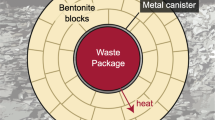Abstract
A number of Hanford tanks have leaked high level radioactive wastes (HLW) into the surrounding unconsolidated sediments. The disequilibrium between atmospheric CO2or silica-rich soils and the highly caustic (pH > 13) fluids is a driving force for numerous reactions. Hazardous dissolved components such as 133Cs, 79Se, 99Tc may be adsorbed or sequestered by alteration phases, or released in the vadose zone for further transport by surface water. Additionally, it is likely that precipitation and alteration reactions will change the soil permeability and consequently the fluid flow path in the sediments. In order to ascertain the location and mobility/immobility of the radionuclides from leaked solutions within the vadose zone, we are currently studying the chemical reactions between: 1) tank simulant solutions and Hanford soil fill minerals; and 2) tank simulant solutions and CO2.
We are investigating soil-solution reactions at: 1) elevated temperatures (60 - 200 °C) to simulate reactions which occur immediately adjacent a radiogenically heated tank; and 2) ambient temperature (25 °C) to simulate reactions which take place further from the tanks. Our studies show that reactions at elevated temperature result in dissolution of silicate minerals and precipitation of zeolitic phases. At 25 °C, silicate dissolution is not significant except where smectite clays are involved. However, at this temperature CO2 uptake by the solution results in precipitation of Al(OH)3 (bayerite). In these studies, radionuclide analogues (Cs, Se and Re - for Tc) were partially removed from the test solutions both during high-temperature fluid-soil interactions and during room temperature bayerite precipitation. Altered soils would permanently retain a fraction of the Cs but essentially all of the Se and Re would be released once the plume was past and normal groundwater came in contact with the contaminated soil. Bayerite, however, will retain significant amounts of all three radionuclides.
Similar content being viewed by others
References
E. K. Wilson, Chemical and Engineering News Sept. 29, 1997 (1997) 30.
D.L. Illman, Chemical and Engineering News June 21, 1993 (1993).
S.F. Agnew, J.G. Watkin, TWRS Characterization Program, report # LA-UR-3590, Los Alamos National Laboratory, Los Alamos 1994.
S.F. Agnew, report # LA-UR-3860, Pacific Northwest National Lab, Richland, WA 1996.
R.J. Serne, M.I. Wood, report # PNNL-7279, DE90013546, Pacific Northwest National Labs, Richland, WA 1990.
R.L. Weiss, report # WHC-SD-WM-ER-309, Pacific Northwest National Lab, Richland, WA 1988.
B.D. Flanagan, report # WHC-SD-WM-TI-591, Pacific Northwest National Lab, Richland 1994.
National Research Council, DOE, Committee on Subsurface Contamination at DOE Complex Sites: Research Needs and Opportunities 1998.
E. M. J. Kupfer, report # HNF-SD-WM-TI-740, Pacific Northwest National Lab, Richland, WA 1997.
R.J. Serne, J.M. Zachara, D.S. Burke, report #PNNL-11495 UC-510, Pacific Northwest National Laboratory, Richland 1998.
L.B. Sand, F.A. Mumpton, Natural Zeolites; Occurrence, Properties, Uses, Pergamon Press, London 1978.
A.J. Ellis, W. A. J. Mahon, Chemistry and Geothermal Systems, Academic Press 1977.
R.M. Barrer, Hydrothermal Chemistry of Zeolites, Academic Press, London 1982.
J. Breck, Zeolite Molecular Sieves, Wiley and Sons, New York 1974.
Author information
Authors and Affiliations
Rights and permissions
About this article
Cite this article
Nyman, M., Krumhansl, J.L., Zhang, P. et al. Chemical Evolution of Leaked High-Level Liquid Wastes in Hanford Soils. MRS Online Proceedings Library 608, 225 (1999). https://doi.org/10.1557/PROC-608-225
Published:
DOI: https://doi.org/10.1557/PROC-608-225




